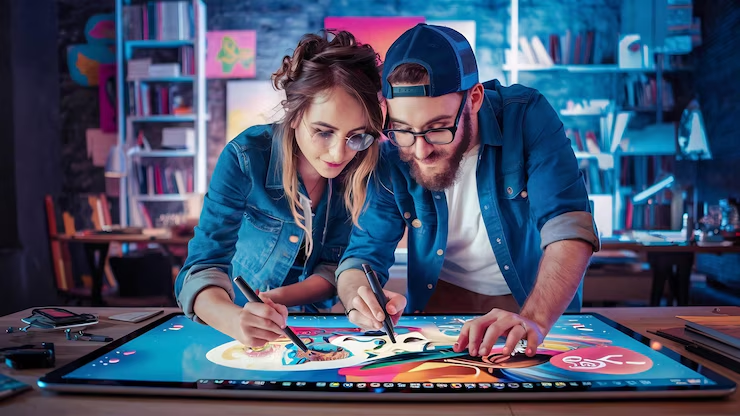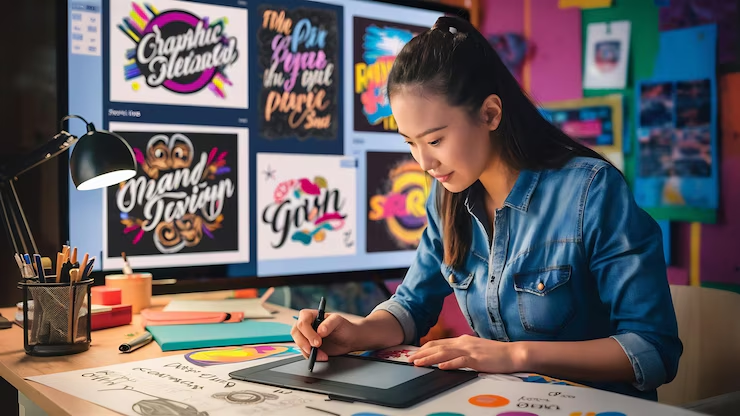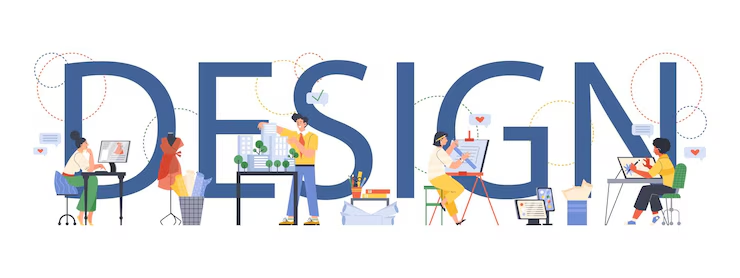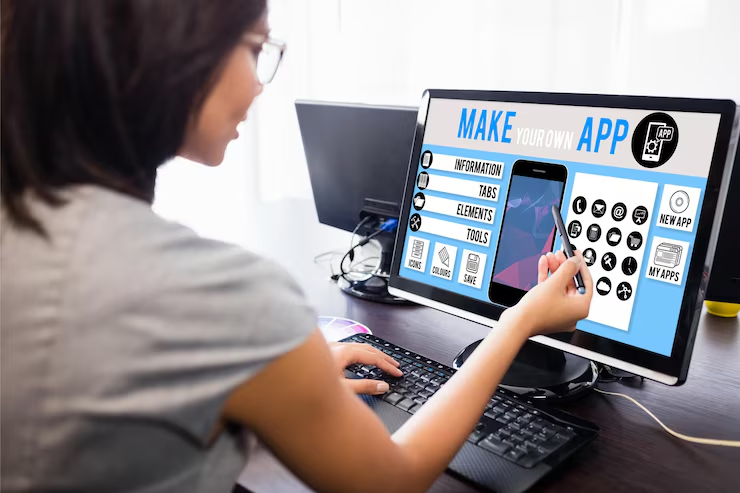Visually, your brand may not complement—but define. Social media graphics have gone through a transition from basic imagery to become tools for engagement, message communication, and, yes, conversion. It's more of the same. If anything, what has happened is further going on in the very direction. Visual style has moved from incorporation into the content-based emphasis now featured as the central engagement prime.
 Therefore, whether it's a start-up or an independent agency or a developing enterprise, professional social media graphics design will enhance your brand visibility, increase recognition, and boost marketing with higher conversions. This article will cover everything you need to know about social media graphics with tips on platform-based design, hiring the right graphic designer, and improving ROI.
Therefore, whether it's a start-up or an independent agency or a developing enterprise, professional social media graphics design will enhance your brand visibility, increase recognition, and boost marketing with higher conversions. This article will cover everything you need to know about social media graphics with tips on platform-based design, hiring the right graphic designer, and improving ROI.
 Social media graphics designing services involve the concept, creation, and delivery of customized visual content to be used across a huge array of social media platforms. Generally these are not graphically defined images; these are branded, goal-oriented, demographic, and audience resonate designs.
Social media graphics designing services involve the concept, creation, and delivery of customized visual content to be used across a huge array of social media platforms. Generally these are not graphically defined images; these are branded, goal-oriented, demographic, and audience resonate designs.
Instagram
Facebook
Twitter
LinkedIn
Pinterest
High-resolution, vertical pin designs Pins tailored for blog or product promotion
 Therefore, whether it's a start-up or an independent agency or a developing enterprise, professional social media graphics design will enhance your brand visibility, increase recognition, and boost marketing with higher conversions. This article will cover everything you need to know about social media graphics with tips on platform-based design, hiring the right graphic designer, and improving ROI.
Therefore, whether it's a start-up or an independent agency or a developing enterprise, professional social media graphics design will enhance your brand visibility, increase recognition, and boost marketing with higher conversions. This article will cover everything you need to know about social media graphics with tips on platform-based design, hiring the right graphic designer, and improving ROI.
What Are Social Media Graphics Designing Services?
 Social media graphics designing services involve the concept, creation, and delivery of customized visual content to be used across a huge array of social media platforms. Generally these are not graphically defined images; these are branded, goal-oriented, demographic, and audience resonate designs.
Social media graphics designing services involve the concept, creation, and delivery of customized visual content to be used across a huge array of social media platforms. Generally these are not graphically defined images; these are branded, goal-oriented, demographic, and audience resonate designs.
Types of Social Media Graphics:
- Instagram Posts & Stories: Eye-catching visuals, reels covers, interactive story designs
- Facebook Graphics: Posts, carousel ads, cover images
- LinkedIn Graphics: Company banners, lead magnets, announcement visuals
- Twitter Visuals: Infographics, announcement graphics
- Pinterest Pins: Long-form graphics, mood boards, shopping posts
- YouTube Thumbnails & Banners: High-click thumbnails, branded channel art
Who Needs These Services?
- Small and medium businesses
- Startups and solopreneurs
- Influencers and content creators
- Digital marketing agencies
- E-commerce brands
Importance of Social Media Graphics in Digital Marketing
Visual Content is King
Posts with visuals in recent research generate 650% higher engagement than those with text only. Short attention spans are serious across the age brackets, which get a chance to on the first impression right away, and in this case, it is usually less than 3 seconds visually.Builds Brand Awareness
Well-designed graphics always carry the brand colors, font, and personality inside. It ensures the creation of settlements for strong visual identity recognition in the long run.Increases Engagement
Brighter colors, innovative design layouts, and interactive features keep users committed to liking, sharing, and commenting—thus an advantage for more organic reach.Supports Content Strategy
Visuals are the carriers of messages. Whether you are advertising a new line or promoting a seasonal sale, visuals improve clarity and serve as a reference for remembering the content.Key Elements of Effective Social Media Graphics
Powerful social media graphics depend on more than creativity; they require an understanding of the important tenets of visual communication to engage an audience. A graphic can work within seconds to catch the viewer's eye, impart a message, and thus affect user behavior. These key elements will lay a strong foundation for social media graphics:1. Visual Hierarchy
Visual hierarchies refer to the considered arrangement of design elements (text, images, icons, and buttons) to direct a viewer's gaze to the most important graphic elements. When operational, visual hierarchies allow for quick and intuitive assimilation of crucial information by the users. Size variation, color contrast, alignment, and spacing are among visual elements used by designers to emphasize headlines, CTAs, or promo text. For instance, a title printed in large letters at the center of the graphic against a contrasting background would attract the most attention, followed by subsidiary text and a very clear CTA button. Without a good hierarchy, even the most beautiful design may not communicate and may instead leave the user feeling confused and disinterested.2. Color Psychology
These are not mere visual elements; they evoke emotions, shape perceptions, and even sway buying decisions. Color Psychology in Social Media Graphics helps to create a bond with the audience. For example, red can symbolize excitement and urgency, while blue stands for trust and dependability. Always select a color that corresponds to either brand or message intentions. Using colors in an appropriate and consistent manner will enhance brand identification through different platforms. Contrasting colors may also be used in highlighting certain aspects like buttons or promotional tags to make such elements visually appealing at once. A considerate color palette supports not just the beauty of the design, but also moves to compel viewers into action.3. Typography
These are not mere visual elements; they evoke emotions, shape perceptions, and even sway buying decisions. Color Psychology in Social Media Graphics helps to create a bond with the audience. For example, red can symbolize excitement and urgency, while blue stands for trust and dependability. Always select a color that corresponds to either brand or message intentions. Using colors in an appropriate and consistent manner will enhance brand identification through different platforms. Contrasting colors may also be used in highlighting certain aspects like buttons or promotional tags to make such elements visually appealing at once. A considerate color palette supports not just the beauty of the design, but also moves to compel viewers into action.4. Consistency
Consistency of presence is essential to instilling an identity and building trust in your brand. Upon setting their eyes on uniform color palettes, font styles, logos, iconography, and image style, audiences begin associating these visuals with your brand. Such visual coherence brings in familiarity and professionalism, elements critical to recall and trust in a brand. In terms of design style, uniformity across different social media platforms means a unified microphone for the brands. Templates with a branding element, maintaining the same tone and formatting, and following a style guide are useful avenues through which a visual content strategy can maintain consistency.5. Call to Action (CTA)
A powerful CTA turns a passive audience into active participants. Social media graphics CTVs map the path for the user to follow, like Swipe Up, Shop Now, Tap to Learn More, Join Webinar. CTAs need to be visible, decisive, and compliant with the intent of the user. Standing out from the content is usually achieved by contrast, button shape, or overt placement according to the visual structure. Not only do CTAs create engagement, but they also boost conversion rates. The combination of persuasive text and catchy design gives CTAs unmatched potential for achieving measurable results via social media.
Social Media Platform-Specific Design Strategies
- Grid layout planning for brand aesthetics
- Reels thumbnails that spark curiosity
- Story highlights with consistent icons
- Engaging post visuals with readable text
- Event flyers and video thumbnails
- Carousel ad layouts for products/services
- Quotes and stats with branded backgrounds
- Thread visuals to increase shares
- Sleek professional banners
- Infographics for lead generation posts
YouTube
- Thumbnails with close-up shots and bold fonts
- Channel banners aligned with brand tone
Benefits of Hiring a Professional Social Media Graphics Designing Service
In today’s exceedingly visual digital landscape, social media graphics are central to getting attention, delivering messages, and driving user actions. Although DIY design tools are within reach, there exists an endless list of advantages in hiring a professional social media graphics designing service that stretches far beyond aesthetics. Here are some compelling reasons as to why appointing a design consultant should perhaps take precedence over many other expenditures for a business:Access to Creative Expertise
One of the greatest advantages of enlisting professional designers is the gear of creative design skills. These guys are conversant with the intricacies of advanced design, such as color theory, typography, layout composition, and visual storytelling. Even more importantly, they get to know, and are current with, the design requirements and trends pertinent to each social media platform—what works great on Instagram could be a turn-off for LinkedIn or Twitter. This very experience allows them to create visuals that catch attention and tactically line up with content objectives and audience expectations in handy forms.Time-Saving
Any graphics that pull people to action need their own charm and promotion, which demands time, especially if one is not a trained designer. This is how outsourcing graphics designing saves quite a worthwhile number of hours for any business that can be used for strategizing, creating content, and focusing on core business needs. Firms could save a great amount of time and work by giving the work to social media graphics designers, thus enabling them to spend their time on other important tasks. Now, this is a scan-off move leading to timely and post 100% smooth publishing across all social media handles.Higher Engagement and ROI
Social graphics that have been made professionally will draw great attention and interactions. Whether it be likes, shares, comments, or clicks, these visuals will drive the engagement that will further impact the reach and eventually the conversion. Catchy images and infographics can seriously improve a post's performance in the algorithm and its visibility. Over a while, it is this engagement that brings better ROI to organic and paid social media activities. In short, better visuals mean better results.Brand Cohesiveness
For the sake of the building trust and recognition, maintaining a consistent branding identity in all communication channels is important. The graphic designer makes sure that every visual element involving colors, typefaces, icons, styles of images, and layouts, align perfectly with the voice of your brand and aesthetic. Such consistency reinforces your brand identity and increases the ability of users to recognize your content in the already crowded world of social media. From daily inductions to intermittent marketing campaigns, consistency in design enhances credibility and professionalism for your brand together.Ad Campaign Success
Social media advertising, paid or not, renders design crucial in deciding whether your campaign floats or sinks. Professionally made ad creatives maximize all opportunity to make them stand out and deliver results. Designers really know how to craft clever-looking graphics that accentuate the offer while coming across with urgency and fold harmoniously into the ad copy and targeting strategies. Well-designed graphics attract clicks by minimizing high bounce rates since they are self-aligned with expectations from the ad on to the landing page. Many cases of great advertising translate to lower CPCs and better conversion rates, making your ad budget more efficient.
How to Choose the Right Social Media Graphics Designer or Agency
Portfolio Review
Examine portfolios or prior work samples of the designer/agency to ascertain the quality of work and design style. The portfolio of a truly versatile designer should show diversity in design, creativity in concept, and consistency in execution. Check for many types of graphics-carousal posts, story templates, reels covers, infographics, ad creatives. The portfolio must also show the ability to create engaging visuals that are brand and industry specific to distinguish themselves. This is your very first and very important glimpse into what they can deliver.Platform Knowledge
Each social media platform has its own visual language, audience expectations, and content requirements. A good designer should know all those ins and outs when developing for different platforms like Instagram, Facebook, LinkedIn, Twitter, Pinterest, and YouTube. For example, an image that works great for a square post on Instagram might flop miserably as a YouTube thumbnail. Be sure to ask your designer if he is aware of the some latest trends on the platform, design dimensions, and engagement tactics. Their expertise in fine-tuning content for each platform can greatly impact how your brand gets looked at and how your content performs.Communication & Responsiveness
Ideas must be communicated clearly if they are ever to be turned into potent designs. You should be looking for a designer or agency that is proactive in all spheres of communication, is giving and accepting feedback, and is very responsive. A designer responds quickly to requests, has a collaborative feedback loop, and provides clear reasons for his design choices. Communication helps keep projects on track and means fewer revisions and, therefore, better results. Choose someone who listens to you but also provides feedback that adds value.Understanding of Branding
Social media graphics must adhere to the latter by way of being branded. To this end, he should know how to interpret your brand guidelines in terms of logo usage, color palettes, typography, tone, and imagery, to ensure that these guidelines are translated into visual messaging. For a good designer, every post he puts out will strengthen the personality of your brand, and, thereby, your company's social media presence will be professional and facilitative of your recall. Strong branding instills trust, inspires followership, and builds loyalty over time.Client Reviews & Case Studies
Use this time to read reviews and case studies by the clients before making a decision. This will give you some idea about the reliability and professionalism of the designer and what they have delivered to other businesses. Look for feedback in relation to creativity, punctuality, communication, and overall satisfaction. Look out for case studies that document improvements in engagement, conversions, and brand recognition derived from the designer's input-these are the best form of evidence. Good reviews and couples with real-life evidence is a good sign that your investment is secure.
The Process of Social Media Graphics Designing
Creating a successful social media graphics strategy involves a very collaborative and creative process alongside brand objectives. Without such a structured workflow, there is a risk of visual asset misalignment with goals, unintended messages creatives intend to communicate, and their ineffective performance across platforms. Below is a step-by-step breakdown of the professional social media graphics designing process:1. Requirement Gathering
Starting with a detailed gaze, this is where the design work comes from the thorough requirement gathering phase. This segment includes knowing the client's brand identity, voice tone, audience, goals for marketing, and overall content strategy. It doesn't matter if it is meant for awareness, engagement, or product launch-in all cases this information is important to get the visuals precisely aligned with the objectives of the campaign. This discussion may include color preferences, type of style, priority of messages, platform focus, or any special call-to-action (CTA) elements that will be included. A crisp design brief is the heart of an effective project.2. Ideation & Conceptualization
Next will be idea generation and visualization techniques and out-of-the-box thinking once everything is clear on requirements. During this creative time, designers study visual themes, proceed with some drafts, and very often create mood boards out of them to present different ways of direction. A meeting of creativity and strategy. Here, designers will make different layout options, go through visual metaphors, and make associations that resonate with the tone of the brand but appeal to its consumers. There may even be ideation on current trends in design sourcing and strategies from competitors to create one's own unique visual concepts.3. Design & Revisions
Once the creative direction has been finalized, designers move on to the actual design of graphics. They use tools like Photoshop, Illustrator, or Canva to compose graphics that talk strongly to the vision that has been agreed upon. Preliminary drafts are then shared with the client for review and feedback, and the revision process would be essential at this stage. Such refinement will bring typographical, color, image placements, or hierarchy changes to great effect in ensuring that the final designs meet the desired expectations.4. Optimization
Post-finalization, the next thing that needs to be done is optimization. Each of these types-specific for a story, carousel, thumbnail, or paid-for advertisement-needs a different layout. Designers adapt and resize the graphics keeping all the specifications in mind so that the design integrity is intact through all revisions. They also optimize file formats for fast loading on both desktop and mobile devices along with sharp clarity. This step includes accessibility through clear fonts, high contrast, and using alt text if needed.5. Delivery & Testing
The ending phase is then delivery and testing of the graphics assets. Designers hand the final files in the required formats like PNG, JPEG, or PSD. In other cases, the assets might directly be uploaded to social media scheduling tools or content management systems. Before launching the visuals, they are cross-tested on every platform for proper rendering and visual impact. Last-minute adjustments will be made to optimize performance, clarity, and brand consistency. Now these graphics can start functioning through campaigns for increased engagement and marketing efforts.
Tools and Technologies Used in Designing Social Media Graphics
- Adobe Photoshop and Illustrator: The de facto industry creative applications when looking for professional design.
- Canva and Crello: Excellent for rapid edits and group collaboration.
- Figma: Ideal for UI and collaborative design processes.
- After Effects: For animated graphics and transitions.
- LottieFiles: Featuring lightweight animation integrations.
- Using AI Tools: Creative concept generation with tools such as Adobe Firefly or DALL.E.
DIY vs Professional Design: Which One to Choose?

Pros of DIY
- Gives value for money to start-ups
- Instant results using pre-designed templates
Cons of DIY
- Little choice for customization
- Imperfect finish
When to Hire Professionals
- When creating a brand, campaign, or posts that are high-risk.
- Whenever scalability and consistency are required
Trends in Social Media Graphics Designing (2025 and Beyond)
- Motion Graphics: A growing way of subtle animations.
- 3D Designs: Giving depth and realism.
- Bold Typography: Catchy headlines in unusual fonts.
- Interactive Elements: Clickable, tappable stories.
- AI & Generative Design: The smarter creation with AI tools.
Pricing Models for Social Media Graphics Designing Services
- Per Graphic: Ideal for one-off needs.
- Monthly Retainers: Best for long ongoing campaigns.
- Bulk Packages: For launching a new brand.
- Customized Plans: Tailored for big enterprises
Social Media Graphics Design Case Studies
Startup A: Boosting Engagement
Transformed brand persona with cohesive LinkedIn and YouTube visual branding.Brand B: Driving Sales
Increased e-commerce conversions by 40% through powerful Instagram carousel ads.Influencer C: Building Identity
Transformed brand persona with cohesive LinkedIn and YouTube visual branding.How Social Media Graphics Integrate with Overall Branding
- Establishes Visual Identity Consistency
- Enhances Brand Messaging by Compelling Visuals













